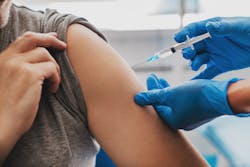We have traveled a difficult and tragic road during the COVID-19 pandemic. Our lives have changed. Now, thanks to new vaccines and a broader adoption of good health practices, we are on the path to restoration – both at home and at work.
We all have a role to play – as do our local, state and federal governments. With this mind, President Joe Biden signed an executive order on his first full day in office instructing the Occupational Safety and Health Administration (OSHA) to revise its COVID-19 workplace safety recommendations. OSHA, which is part of the U.S. Department of Labor, was created by Congress in 1970 to ensure the safe and healthy working conditions by setting and enforcing standards and by providing training, outreach, education and assistance.
President’s Biden’s Executive Order described the effort to combat COVID-19 in the workplace as “a national priority and a moral imperative.”
Accepting the challenge (as they are legally obligated to do), OSHA abided by President’s Biden’s Executive Order and took what it described as a first step – issuing updated COVID-19 guidance known as, “Protecting Workers; Guidance on Mitigating and Preventing the Spread of COVID-19 in the Workplace.” The latest guidance builds on the agency’s prior recommendations – but also includes new recommendations on new topics not previously addressed in prior OSHA guidance.
The OSHA COVID-19 Prevention Program
The OSHA guidance (available at www.osha.gov/coronavirus/safework) recommends that employers implement a COVID-19 prevention program, which should include the elements below, and broad adoption of these recommendations in a workplace will protect workers and the company.
While the OSHA guidance is not legally binding on employers, this could change in the coming months. So, on the chance that mere guidance become binding regulation, employers would be wise to take heed of this guidance, stay informed of any new developments and be mindful that, under the new administration, OSHA is likely to increase its inspection and citation efforts in the coming months.
Here are the elements of the OSHA COVID-19 Prevention Program:
- Assign a COVID-19 workplace coordinator;
- Identify potential COVID-19 hazards in the workplace;
- Adopt policies for sending employees home, physical distancing and improving ventilation
- Protect at-risk workers;
- Communicate policies in a language that workers understand
- Provide education and training on office policies, basic facts about the disease and the employer’s prevention program;
- Adopt non-punitive absence policies;
- Allow for remote work;
- Isolate anyone who exhibits symptoms;
- Perform enhanced cleaning and disinfection, particularly after a confirmed infection;
- Provide guidance on testing;
- Document and report infections and deaths;
- Protect anyone who raises concerns about workplace safety – even where such concerns are raised in public forums, such as social media;
- Provide COVID-19 vaccine at no cost to all eligible employees; and
- Require face coverings or physical distancing, even for those who are vaccinated.
Employer Vaccination Programs
OSHA also recommends that employers develop a vaccination program by scheduling vaccinations, providing them at no cost and educating personnel about the safety and efficacy of such vaccinations. Again, this is not mandatory, only suggested; however, this is among the requirements that could eventually be given the force of law given the criticality of vaccinating the American workforce and populace.
In my column last month (www.securityinfowatch.com/21206991), I noted that employers may require employees to get vaccinated – provided that reasonable accommodations are made for those who cannot receive a COVID-19 vaccine due to a disability or a sincerely held religious belief. Nothing in this latest OSHA guidance changes these exceptions, but employers are all highly encouraged to vet any claimed exceptions and to vaccinate as many workers as possible within the bounds of the law.
Also, OSHA recommends that COVID-19 policies not distinguish between workers who are vaccinated and those who are not. Instead, all workers should continue to follow all safety measures until further guidance from OSHA and/or the Centers for Disease Control.
The OSHA guidance also recommends that employers follow state or local guidance for COVID-19 screening and viral testing and inform employees of their workplace testing requirements and options. Employers may incorporate COVID-19 testing in their COVID-19 prevention programs.
Reporting Unsafe Working Conditions
Unlike the 2020 guidance from OSHA, the latest OSHA guidance explicitly states employers are prohibited from discharging or discriminating against an employee for speaking out about unsafe working conditions or reporting an infection or exposure to COVID-19 to the employer or OSHA.
The OSHA guidance further recommends that employers: notify workers of their rights to a safe workplace; ensure that workers are referred to the employer’s COVID-19 coordinator; prohibit retaliation for raising workplace safety concerns; and consider setting up an anonymous process for complaints relating to the COVID-19 program.
OSHA has also stated that it will update this guidance over time to reflect developments in science, best practices and standards.
Timothy J. Pastore, Esq., is a Partner in the New York office of Montgomery McCracken Walker & Rhoads LLP (www.mmwr.com), where he is Vice-Chair of the Litigation Department. Before entering private practice, Mr. Pastore was an officer and Judge Advocate General (JAG) in the U.S. Air Force and a Special Assistant U.S. Attorney with the U.S. Department of Justice. Reach him at (212) 551-7707 or by e-mail at [email protected].





